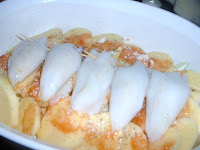
There must be a million cheese cake recipes just waiting to be made each one boasting a special ingredient making it unique and promising to be the best one ever.
Each new cheese cake recipe that looks interesting joins my recipe to try out file. There's actually a file folder entirely devoted to cheese cakes.
There is however one cheesecake I often make that has come a long way from very humble beginnings. There are many versions of this recipe that have most likely been passed down from generation to generation but this recipe holds sweet memories for me.
Torta di Ricotta is the Italian version of the well loved cheesecake and is a little different than the traditional cream cheese version.
Even though I was quite young at the time, I vividly remember my first encounter with this Italian delicacy. It was a time in our lives when everything was very family oriented and everyone showed up for every life event, big or small.
The elderly mother of my Aunt Caterina was visiting from the old country one summer and as usual anyone available showed up at the airport to give her a warm welcome.
As she approached us from the arrival gate we noticed a little white bundle in her hands and she was holding on to it as if it was her most precious possession.
It was wrapped in a white cloth napkin, the ends drawn up the sides and tied in a tidy little knot in the center.
At the reveal we found out that it was a ricotta cheesecake still in the little pan that it was baked. It was made from three simple ingredients, ricotta, eggs and sugar. She must have held on to it throughout the whole flight.
I remember my mother occasionally making this type of cheesecake for us but she added some orange and lemon zest and a crust. The citrus zest was an improvement but the crust as I remember it did not leave me with fond memories.
I eventually tried my hand at baking this cheesecake knowing only the basic ingredients but no exact measurements. So what else is new?
Now here is a recipe that I intentionally made changes to until I ended up with satisfying results and wins the approval of most who try it.
The addition of a few new ingredients, a flaky crust and a few changes in the method of preparation has helped this cheesecake come a long way from the one in that sweet little white bundle.
Torta di Ricotta (Italian Cheese Cake)
Filling
2 containers of smooth ricotta (a total of 800 to 900 grams)
3 large eggs
¾ cup granulated sugar
¼ cup flour
½ cup mini chocolate chips
¼ cup finely chopped maraschino cherries (well drained)
Finely grated zest from one lemon and one orange
- Place ricotta in a bowl and beat until smooth with mixer.
- In a separate bowl beat the eggs until frothy, gradually add sugar and continue beating until light and fluffy.
- Add egg mixture to cheese mixture and beat together with mixer until well blended, add flour continue mixing until smooth.
- Stir in orange and lemon zest, chocolate chips and maraschino cherries.
- Make a shortening crust as in my post for Apple Pie.
- Cut off 1/3 of the dough and reserve for lattice on top of cake.
- Roll remaining dough until large enough to fit into a square 8 or 9 inch baking dish.
- Add prepared cheese filling.
- Roll remaining dough, cut into strips and place like a lattice over cheese filling.
- Sprinkle top generously with granulated sugar.
- Bake at 400 degrees F. until light golden brown, about 45 minutes.
- Turn oven off, leave door ajar and leave cake in the oven for about 20 minutes.
- Remove from oven and cool completely on wire rack.
- Refrigerate, when cold cut into small squares (20 to 24 squares)
- Store in refrigerator.





Notes, Tips and Suggestions
- It’s a good idea to drain the ricotta in a small colander overnight or at least a few hours to remove excess moisture.
- Ricotta can usually be purchased in 400 or 450 gram tubs. Total amount used can be between 800 and 900 grams
- Making sure cheesecake is cold before cutting ensures neat clean results
To the best of my knowledge this tool is called a pastry wheel.

I've used it for so many years until....

They call it a Pasta Bike. I'm not sure why it is called so but besides cutting pasta dough into fancy noodles and lasagna strips or cutting uniform squares for ravioli and cappelletti it makes cutting lattice pastry strips a breeze! The removal of some of the wheels will cut strips into the preferred width.

























